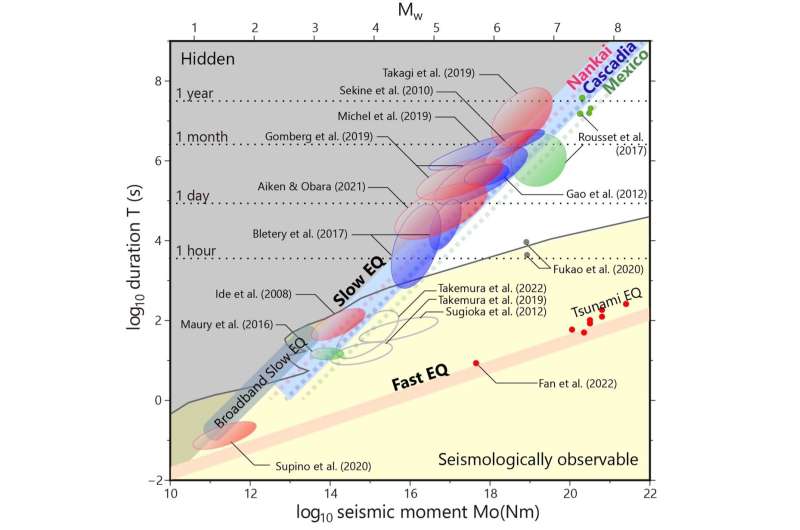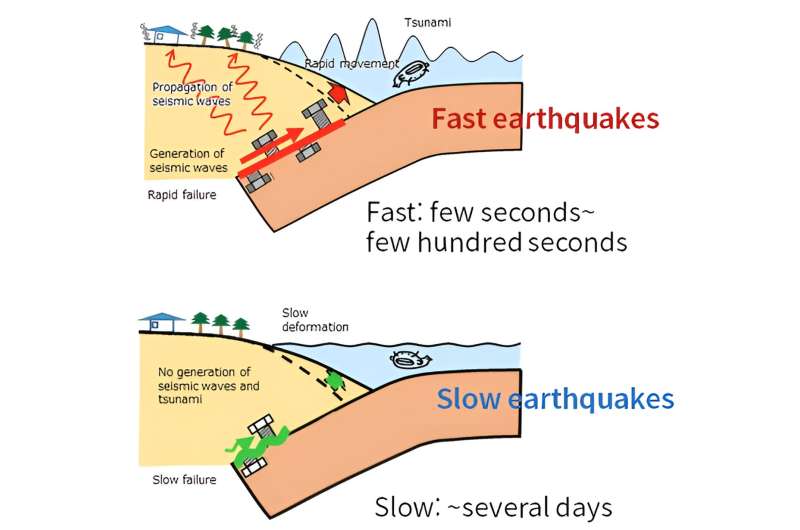This article has been reviewed according to Science X's editorial process and policies. Editors have highlighted the following attributes while ensuring the content's credibility:
fact-checked
peer-reviewed publication
trusted source
proofread
New study shows how to distinguish between slow and fast earthquakes

Researchers from the University of Tokyo and Stanford University show what differentiates slow and fast earthquakes and how their magnitudes vary with time.
Normally, earthquakes last up to a few minutes and radiate strong seismic waves. But around 23 years ago, scientists discovered an unusual slow-slip phenomena called slow earthquakes. Slow earthquakes last days or even months. Though they involve significant tectonic movement, you may never feel them. Since slow earthquakes could indicate future fast earthquakes, monitoring and understanding them helps accurately forecast devastating earthquakes and tsunamis.
Understanding them requires knowing how they change over time. For that, researchers use scaling laws which define the relationship between two quantities over a wide interval. In 2007, researchers proposed a controversial scaling law relating the magnitude and duration of earthquakes, which can help differentiate slow and fast earthquakes.
According to the scaling law, for slow earthquakes, as its magnitude (measured by a quantity called seismic moment) increases, the duration of the earthquake increases proportionately. For fast earthquakes, the relation is not linearly but cubically proportionate, which means the seismic moment increases very rapidly in a short time.
The scaling law received criticism from other researchers and raised questions about the likelihood of events in between slow and fast earthquakes that do not fall within the law. Seismologists Satoshi Ide of the University of Tokyo and Gregory Beroza of Stanford University now bolster the scaling law with more data, reinterpret the scaling relation, and address the controversy.

"Most of the challenges to the scaling law were problematic, but we have had no chance to disprove their challenges," says Ide. "A surprise was that totally erratic results were published in Nature, and believed by many scientists, who made further problematic numerical models."
With the advent of new seismic detection technology and data accumulated over 16 years, Ide and Beroza now reason that most arguments against the law had improper data calculations and were inconsistent given their data constraints. They suggest the presence of a speed limit to slow earthquakes and reveal physical processes that differentiate slow and fast earthquakes.
The work is published in the journal Proceedings of the National Academy of Sciences.
Many, but all the same
Since slow earthquakes include phenomena with different frequency bands, they are more diverse than fast earthquakes. They were named differently, such as low-frequency earthquakes, tectonic tremors, very low-frequency earthquakes, and slow slip events.
So, researchers observing one type of slow earthquake considered other types irrelevant. "Our study confirmed that all these phenomena are mutually connected, or rather regarded as a single phenomenon that radiates various signals," explains Ide.
Slow slips, but not so fast
Slow earthquakes are so subtle and inaccessible that detecting and monitoring them is challenging. Due to the detection bias, only large enough slow earthquakes are observed. That prompted Ide and Beroza to propose an upper limit to the speed of slow earthquakes.
Based on that, the duo redefined the 2007 scaling law with the maximum value constraint. As they showed continuous evidence for the scaling law over a broad time scale of less than a second to more than a year, they put an end to the debate.
How are slow and fast earthquakes different?
When Ide's group proposed the scaling law in 2007, they were unsure of what makes these two earthquake types different. Now, with more data and theoretical models, Ide and Beroza show that their scaling differences dictate physical movement processes governing the events. Diffusion processes govern slow earthquakes, whereas seismic wave propagation dictates fast earthquakes. Because of this difference, the magnitude of slow earthquakes cannot be as large as fast earthquakes when the event lasts longer.
"We pointed out that 'diffusion' is important in slow earthquakes, but what is physically diffusing is not well understood," says Ide.
Experts still don't know what kind of forecast information they can provide based on slow earthquake monitoring. This study will be a foundation for building appropriate numerical models, making predictions, and taking countermeasures.
More information: Ide, Satoshi et al, Slow earthquake scaling reconsidered as a boundary between distinct modes of rupture propagation, Proceedings of the National Academy of Sciences (2023). DOI: 10.1073/pnas.2222102120
Journal information: Proceedings of the National Academy of Sciences , Nature
Provided by University of Tokyo





















